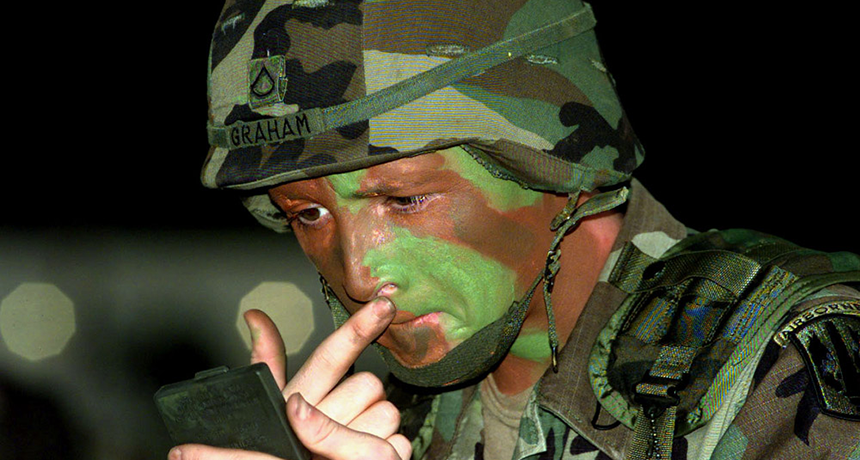Heat-resistant makeup
New recipe for camouflage face paint could protect soldiers against burns from bomb blasts

During field operations and military exercises, many soldiers use camouflage makeup to blend into the environment. A new type of makeup may also help protect troops against burns from bomb blasts.
Spc. Gerald James, U.S. Army
Share this:
- Share via email (Opens in new window) Email
- Click to share on Facebook (Opens in new window) Facebook
- Click to share on X (Opens in new window) X
- Click to share on Pinterest (Opens in new window) Pinterest
- Click to share on Reddit (Opens in new window) Reddit
- Share to Google Classroom (Opens in new window) Google Classroom
- Click to print (Opens in new window) Print
By Sid Perkins
When you hear the word “makeup” you may think about the stuff your sister uses to cover a zit. Or maybe you imagine what your aunt uses to camouflage wrinkles or dark spots. But sometimes makeup serves to hide not a facial imperfection but rather the whole face. Consider hunters and soldiers. They may paint their faces a mix of green, brown and other natural colors to blend into the environment.
Now, researchers have developed a new type of camouflage makeup for troops. Its added advantage: It helps protect soldiers from the hot blast of a nearby explosion, such as those from the roadside bombs. These explosives have injured many troops in Iraq and Afghanistan.
An explosion produces powerful pressure waves. It also generates an intense wave of heat that can exceed 600° Celsius (1,112° Fahrenheit). That temperature is as hot as a burning cigarette. Although the blast wave lasts only about 2 seconds, it’s long enough to burn the upper layers of a soldier’s face, hands or other exposed skin surfaces.
Developing a makeup to protect soldiers from such intense heat was a big challenge, says Robert Lochhead. He’s a polymer chemist at the University of Southern Mississippi in Hattiesburg. (A polymer chemist specializes in the design, manufacture, use and anaysis of chemical substances whose molecules are long chains made of repeating groups of atoms.)
For starters, the new face paint had to have all the characteristics of makeup that soldiers now use. That means it had to be easy to apply and remove. It had to be waterproof. It could not irritate the eyes, nose or mouth. And it could not rub off easily. Like today’s makeup, it also had to come in light brown (“sand”), dark brown (“soil”), green (“jungle”), white (“snow”) and black colors. Finally, it had to include as much as 35 percent DEET. That’s an insect repellent, but one that happens to be highly flammable.
For their heat-masking camouflage, Lochhead and his team replaced traditional ingredients that can easily burn — like hydrocarbons, fatty substances and mineral oil — with heat-resistant alternatives. His team chose silicones. They relied on the usual pigments to generate all of the colors they needed. But the team used a special chemical technique to make individual particles of pigment come together into large clumps. This helped the makeup reflect the heat of a blast. (That trick was previously developed by other scientists, says Lochhead.) Finally, the team mixed in the DEET. But rather than adding it as a liquid, they packed the insect repellent inside microscopic capsules of a gel-like material. This gel also holds water. That trick helps keep the repellent from catching fire.
Lochhead described his team’s new makeup on August 22 at the American Chemical Society meeting in Philadelphia.
“This research is very interesting,” says Anjali Patil, a senior scientist at cosmetics company Revlon in Edison, N.J. “They’re using polymers and pigments in a different way.”
Tests suggest that the new makeup can protect a soldier’s face and hands for up to 15 seconds before its own temperature rises to 60°C (140°F), the point at which mild burns can occur. In some situations, the new recipe provides protection from heat for as much as 1 minute. That suggests a colorless version of this makeup might be useful for firefighters or other people occasionally exposed to extreme heat on the job.
“I’m really impressed with this work,” says Jamil Baghdachi. He’s a polymer scientist at Eastern Michigan University in Ypsilanti. “This is one of the most practical applications of science that I’ve seen.”
Power Words
camouflage Techniques and patterns that enable otherwise visible objects to remain unnoticed by blending with their environment. Examples include the spotted pattern on a young deer’s coat, the shape and color of certain butterflies and stick insects, and the colors and patterns often seen on hunting gear and soldiers’ uniforms.
pigment A material used to change the color of light reflected off of an object or transmitted through it. The overall color of a pigment typically depends on which wavelengths of visible light it absorbs and which ones it reflects. For example, a red pigment tends to reflect red wavelengths of light very well and typically absorbs other colors.
polymer Substances whose molecules are made of long chains of repeating groups of atoms. Manufactured polymers include nylon, polyvinyl chloride (better known as PVC) and many types of plastics. Natural polymers include rubber, silk and cellulose (found in plants and used to make paper, for example).
silicone Heat-resistant substances that can be used in many different ways, including the rubber-like materials that provide a waterproof seal around windows and in aquariums. Some silicones serve as grease-like lubricants in cars and trucks. Most silicones, a type of molecule known as a polymer, are built around long chains of silicon and oxygen atoms.







